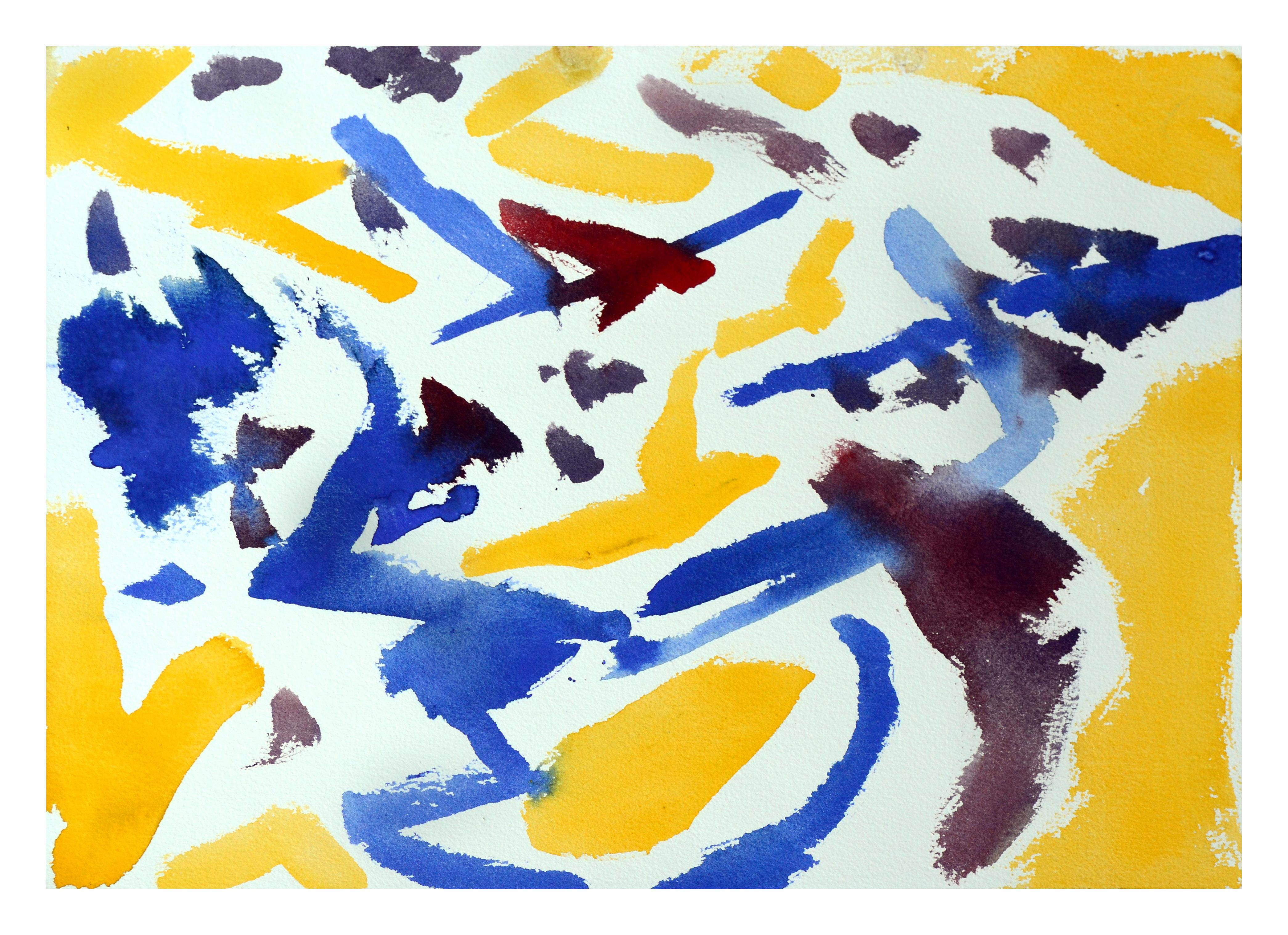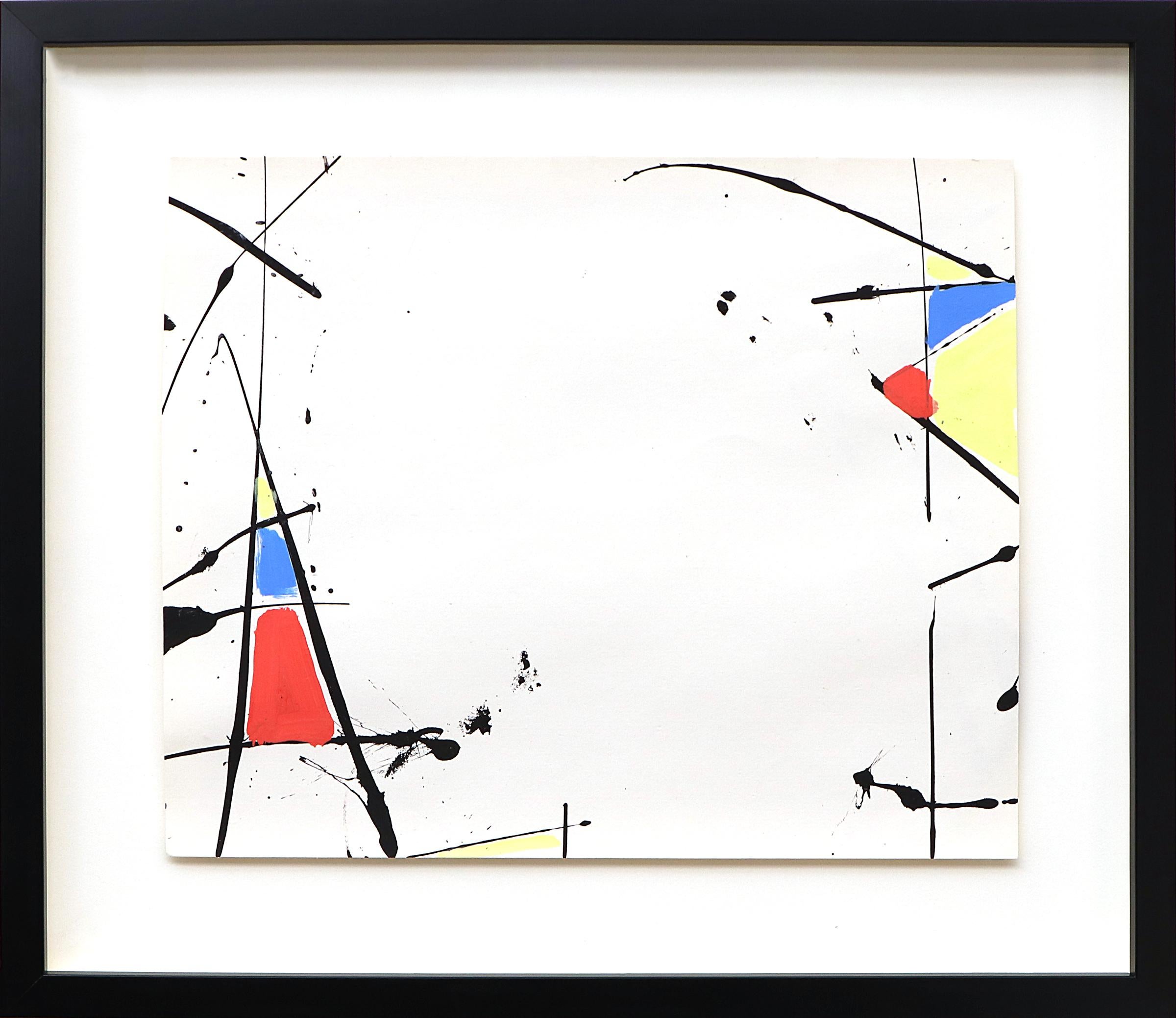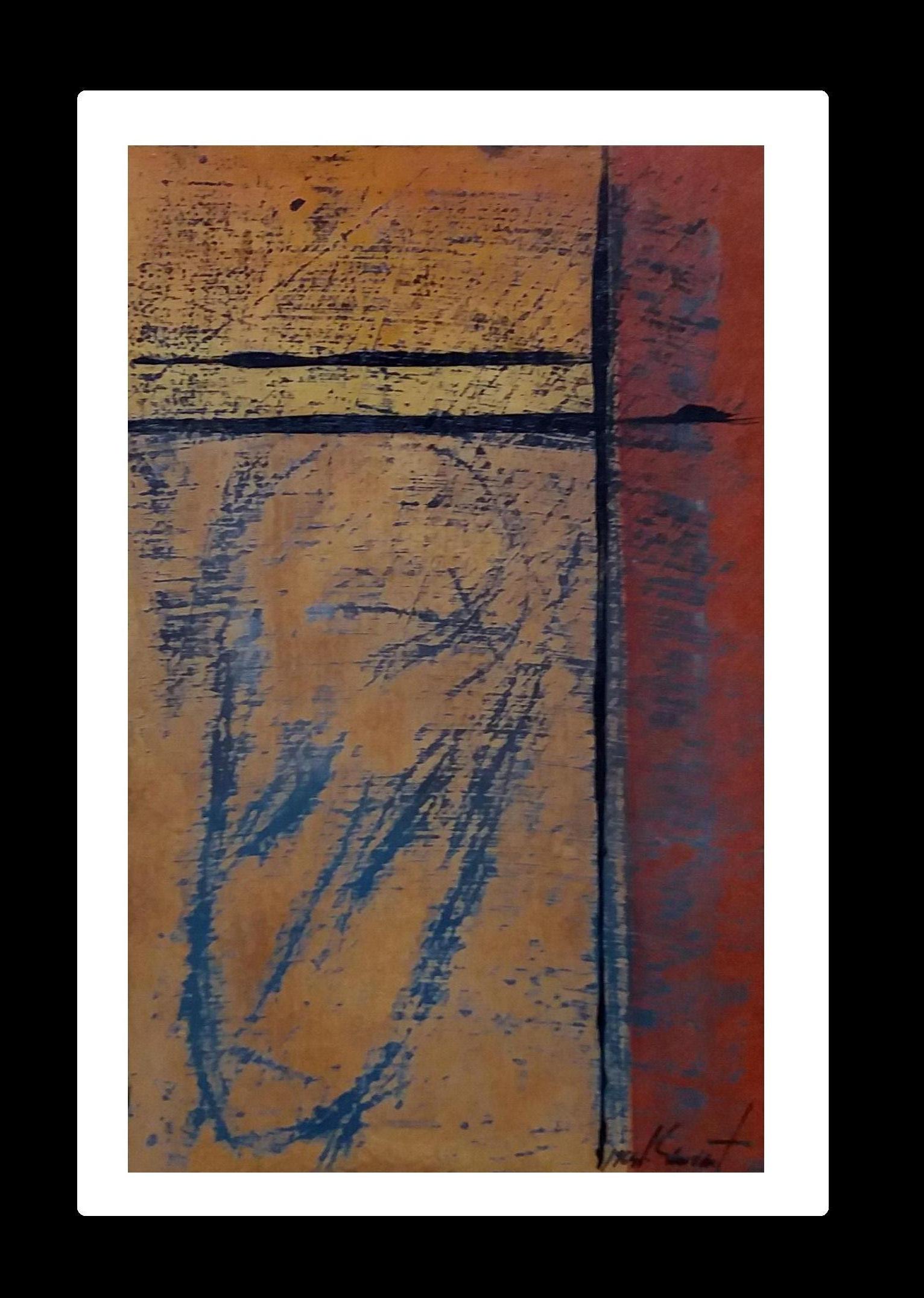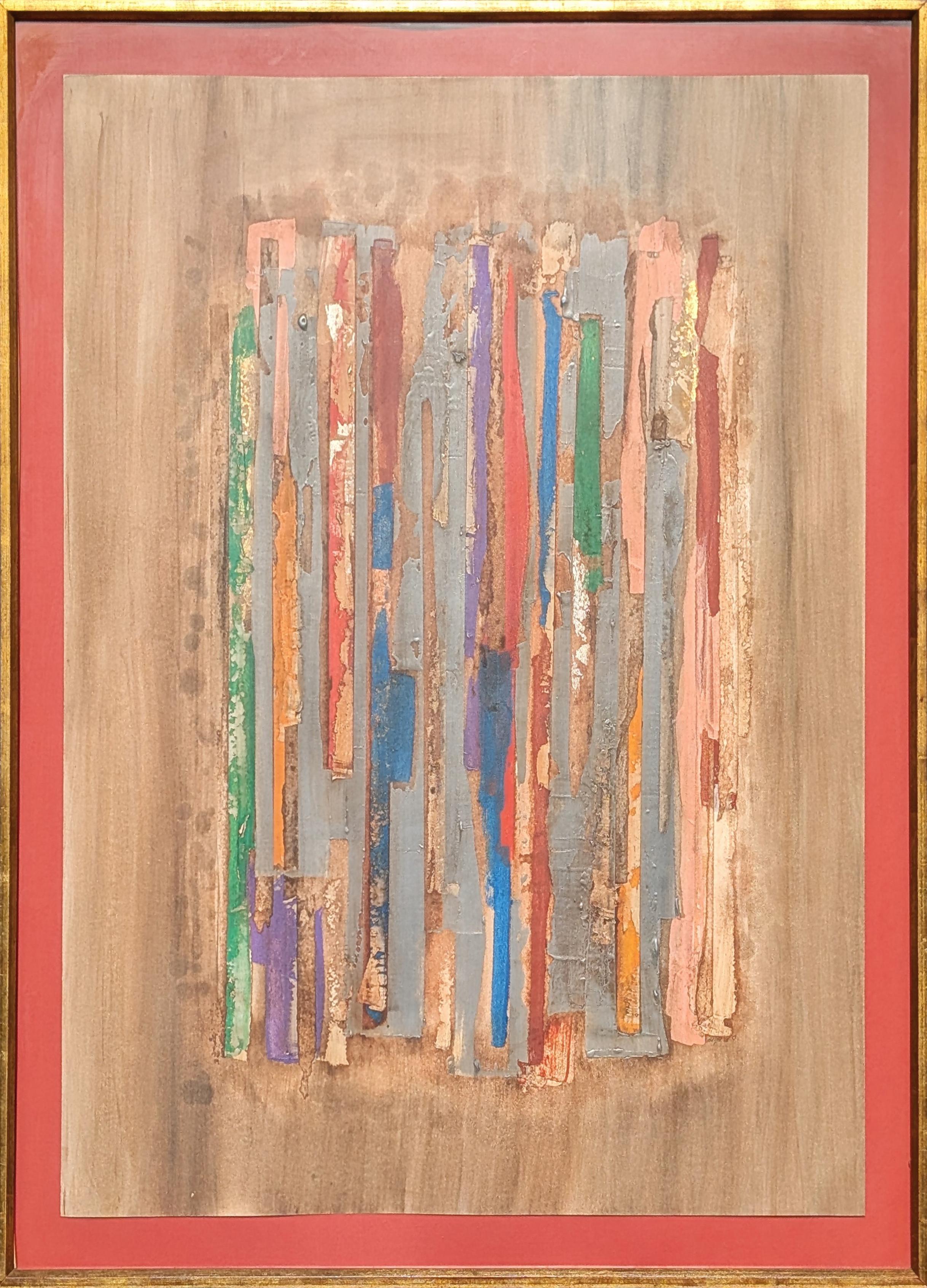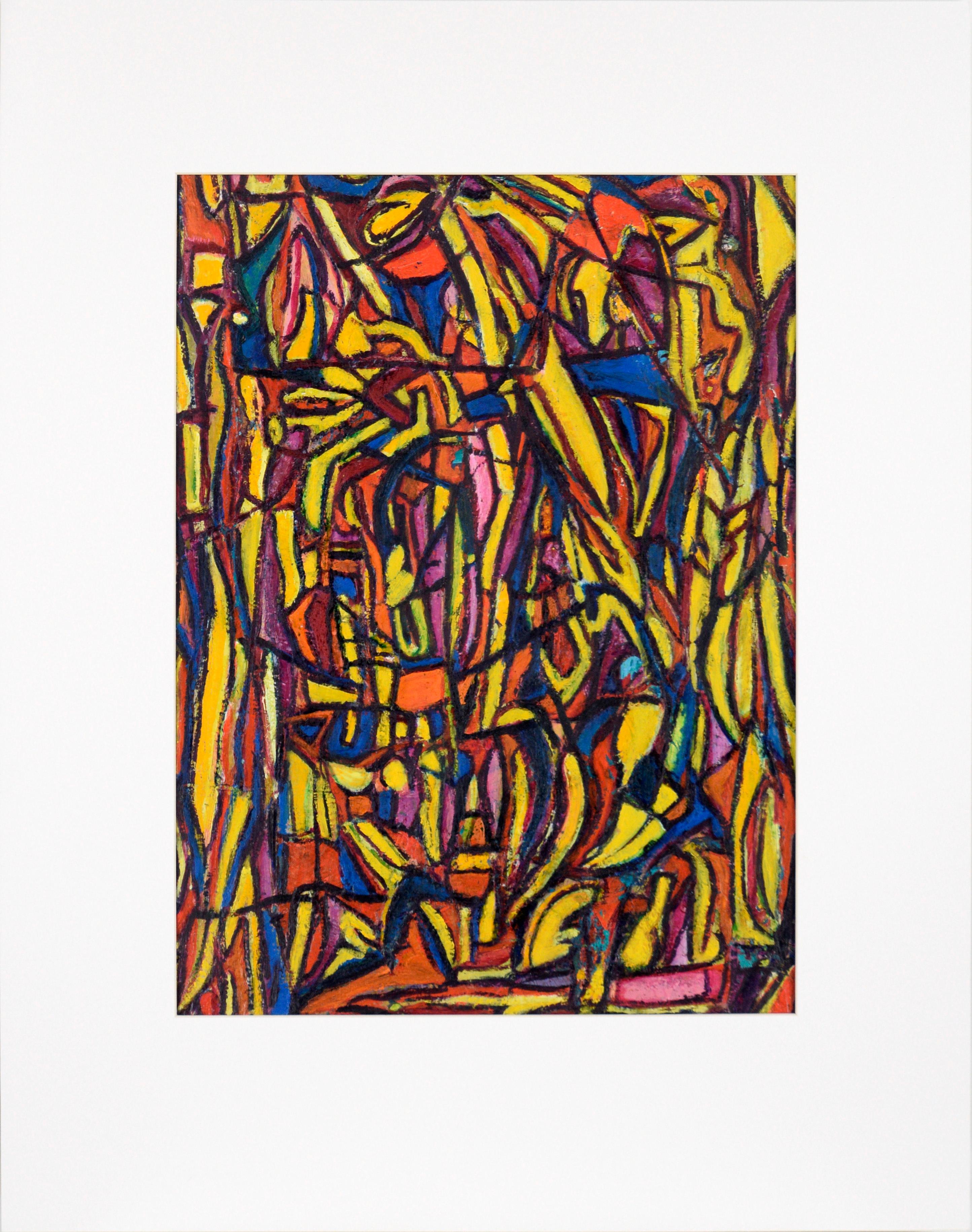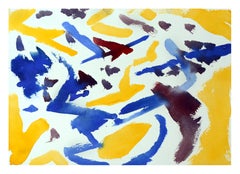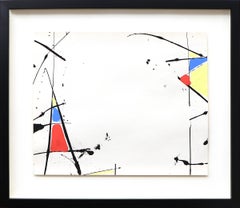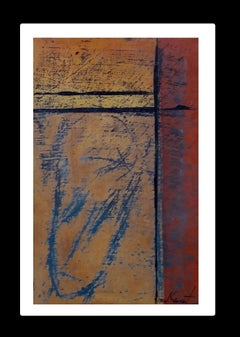Items Similar to Yellow Spike - British 60's Abstract art blue red grey COBRA Scottish artist
Want more images or videos?
Request additional images or videos from the seller
1 of 13
William GearYellow Spike - British 60's Abstract art blue red grey COBRA Scottish artist1962
1962
$2,859.28
$3,574.1020% Off
£2,080
£2,60020% Off
€2,436.02
€3,045.0320% Off
CA$3,993.41
CA$4,991.7720% Off
A$4,330.95
A$5,413.6920% Off
CHF 2,274.78
CHF 2,843.4820% Off
MX$52,607.03
MX$65,758.7920% Off
NOK 28,465.28
NOK 35,581.5920% Off
SEK 26,801.65
SEK 33,502.0620% Off
DKK 18,186.58
DKK 22,733.2220% Off
About the Item
An original silkscreen print by Scottish COBRA listed artist William Gear. An internationally famous abstract artist, Gear was a member of the COBRA group which was famous in the fifties and sixties for its abstract art. This trial proof 1/25 limited edition silkscreen is titled Yellow Spike and is typical of his work of the period. His prints are rare to market and his oils now command tens of thousands at auction and even higher at galley level. This is an exceptional example of a mid 20th century Scottish COBRA artwork. The colouring and condition are very good. It is a large size and signed with good provenance. Mid 20th century abstract artwork like this can be seen on display at Galleries and art fairs. This is a very good example of his work. A delightful painting.
Signed Gear '62 and titled Yellow Spike 1/25.
Provenance. PLC collection Scotland.
Condition. Large original silkscreen print. Image 27 inches by 16 inches and in very good condition. The colour is remarkable.
Housed in gallery frame which compliments the picture 40 by 28 inches, in very good condition.
William Gear (1915-1997). Few British painters have played an active role in the modern abstract movement of post-war Europe. William Gear was the most passionate and committed exception. He continued the tradition of the Edinburgh-Paris axis established by J.D. Fergusson, Samuel Peploe and others, spending vital years between 1947 and 1950 living and working in Paris. Significantly, in recent years, he received the greatest acclaim in France, Germany and the Netherlands. He was born in 1915 in Methil, Fife, into a mining family; the particular landscape of "pitheads, the sea, rocks, castles, trees, storms and poverty" marked his earliest identity with a place and probably remained the most influential to his art. Years later he recalled as a schoolboy visiting the local art gallery in Kirkcaldy and seeing 12 colourful still-lifes by Peploe. Art-history lessons during student years at Edinburgh College of Art, in particular Byzantine classes under David Talbot Rice, also influenced his concern for structure. This had as much to do with the formal language of painting as sheer delight in the medium itself. Gear never missed an opportunity to show people the merits of a well-constructed painting. On a travelling scholarship in 1937, he chose to study with Fernand Leger, described by Gear as "a keystone for me, seldom abstract, rather a degree of abstraction". The Second World War interrupted these formative years and, by 1940, Gear had joined the Royal Corps of Signals. Dispatched to the Middle East, he still had the discipline to paint - mostly works on paper of damaged landscapes - with exhibitions in Jerusalem, Tel Aviv, Cairo as well as Siena and Florence. His naturally robust and tenacious temperament was profoundly affected by visiting Bergen-Belsen, and this certainly influenced the later experiments with the black armature. As the British officer in Celle, working for the Monuments, Fine Arts and Archives Section of the Control Commission, he focused on securing the safety of the Berlin Art Collection in Schloss Celle, and organised an important series of modern art exhibitions, including the rejected work of Karl Otto Gotz. Only a few weeks before his death, this service to "democratic art and artistic freedom" was recognised in Hanover by a unique Leporello Award, appropriately instigated by fellow artists and presented by the Lower Saxony government. Demobbed in 1947, Gear headed for Paris, where he established a one-room studio at 13 Quai des Grands Augustins. This exciting period saw him gravitating towards what he called "the freer, dramatic approach of abstraction lyrique" rather then "the dogmatic hard-edged school of Mondrian and De Stijl". Within a year there were exhibitions at two of the pioneering salons and a first one-man show at the Galerie Arc en Ciel. At the same time inclusion in Cobra shows in Amsterdam and Copenhagen in 1949, alongside Constant, Corneille and Appel, underpinned his affiliation to a reinvigorated form of abstract expressionism. He worked at the time in the fluid medium of opaque water-colour, usually on card with pockets of intense colour on a white or neutral ground. While some pieces were purely abstract, others carried their own suggestion of landscape, or even a form of Celtic figuration. The same year saw an exhibition at the Betty Parsons Gallery in New York, alongside Jackson Pollock. The impact of American abstract expressionism however remained a sore subject, which in conversation was usually dismissed with a curt reminder of what he and others were already painting in Europe. The decision to return to England in 1950 was both personal and practical. Recently married to Charlotte Chertok, and with a baby, he had already secured in 1948 the first of a series of London exhibitions with the Gimpel Fils Gallery. The atmosphere surrounding the Festival of Britain also appeared to offer fresh opportunities. Notoriously, Gear was awarded one of the Festival of Britain Purchase Prizes for Autumn Landscape, a large oil on canvas which took six difficult months to complete. The event produced written questions and answers in the House of Commons and a tirade of abuse from the national press, not to mention a topic for debate on the radio programme Any Questions. While the episode made him a household name, the longer-term effects were, arguably, more detrimental. He chose not to live in London or join fellow abstract artists in St Ives, preferring the independence of a village in Kent between 1953 and 1958. This period saw the continued development of large landscape structures, as well as "side-roads" into sculptural subjects and minimalist colour paintings, which openly acknowledged the influence of Nicolas de Stael. These works have still to be properly exhibited. Mau-Mau (1953), for example, painted for the Contemporary Art Society but at the last minute withdrawn from display at the Tate Gallery, has its first London showing in the current golden jubilee exhibition at the Redfern Gallery. Gear was out of critical favour for most of the 1960s and 1970s. He exhibited more irregularly, despite returning to the use of dark structures broken by selected movements and light-inflected primary colours. While contemporaries questioned his move to Eastbourne as Curator of the Towner Art Gallery (1958-64), Gear's response was to take on the Purchase Committee. He changed the local authority's collection policy from Victorian and local views to securing the foundation of a major collection of post-war British art. His move to Birmingham came with the appointment as Head of the Faculty of Fine Art, Birmingham College of Art, in 1964, a post held until retirement in 1975, by which time he had become increasingly un- interested in the growing bureaucracy surrounding art education. His support and encouragement to artists living in Birmingham however continued with the purchases made for Birmingham Museums and Art Gallery on behalf of the Friends organisation (1987-94) as well as for his own personal collection. Most recently he instigated the idea of a gallery of modern art in Birmingham. Fortunately, the last 15 years have also gone some way to reverse the years of neglect. Gear and Stephen Gilbert (also Scottish) were the only British artists included in the major Cobra 1948-51 exhibition at the Musee d'Art Moderne, Paris, in 1982. The Cobra enthusiast Karel van Stuijvenberg has been a prominent patron and, in 1995, Gear took delight in attending the opening of the Cobra Museum of Modern Art in Amstelveen, near Amsterdam. He was equally proud of his long overdue election to the Royal Academy in 1995, and in the last years relished working with the fluidity and strong colours of oil stick. Tessa Sidey. Exhibited and held by worldwide galleries including The Tate.
- Creator:William Gear (1915-1997, Scottish)
- Creation Year:1962
- Dimensions:Height: 40 in (101.6 cm)Width: 28 in (71.12 cm)Depth: 2 in (5.08 cm)
- Medium:
- Movement & Style:
- Period:
- Condition:
- Gallery Location:Hagley, GB
- Reference Number:1stDibs: LU853113244572
About the Seller
5.0
Platinum Seller
Premium sellers with a 4.7+ rating and 24-hour response times
1stDibs seller since 2018
463 sales on 1stDibs
Typical response time: <1 hour
- ShippingRetrieving quote...Shipping from: Hagley, United Kingdom
- Return Policy
Authenticity Guarantee
In the unlikely event there’s an issue with an item’s authenticity, contact us within 1 year for a full refund. DetailsMoney-Back Guarantee
If your item is not as described, is damaged in transit, or does not arrive, contact us within 7 days for a full refund. Details24-Hour Cancellation
You have a 24-hour grace period in which to reconsider your purchase, with no questions asked.Vetted Professional Sellers
Our world-class sellers must adhere to strict standards for service and quality, maintaining the integrity of our listings.Price-Match Guarantee
If you find that a seller listed the same item for a lower price elsewhere, we’ll match it.Trusted Global Delivery
Our best-in-class carrier network provides specialized shipping options worldwide, including custom delivery.More From This Seller
View AllAbstract in Yellow Green & Red - British 1955 abstract art oil painting
Located in Hagley, England
This superb British 1950's abstract oil on board painting is by noted Slade School trained contemporary artist Leo Davy. Davy was born in Yorkshire but settled in Cornwall in 1968 an...
Category
1950s Abstract Abstract Paintings
Materials
Oil
$8,797 Sale Price
20% Off
Blue Yellow abstract - British sixties Abstract art oil painting
By Peter L. Field
Located in Hagley, England
This vibrant British abstract is by noted artist Peter L Field. Painted circa 1960, the composition is in blues and yellow/browns with Field's striking h...
Category
1960s Abstract Abstract Paintings
Materials
Oil
$3,959 Sale Price
20% Off
Red Idol - British 50's art abstract oil painting - Modernist COBRA - provenance
By William Gear
Located in Hagley, England
An original oil on canvas by the noted Scottish artist William Gear. A fabulous painting. One of his best and a seminal work which dates to 1959.
Provenance. Douglas Foulis Art Galle...
Category
1950s Abstract Abstract Paintings
Materials
Oil
$35,191 Sale Price
20% Off
Fifties Abstract - British 1954 abstract art oil painting Slade School artist
Located in Hagley, England
This superb British 1950's abstract oil on board painting is by noted Slade School trained contemporary artist Leo Davy. Davy was born in Yorkshire but settled in Cornwall in 1968 an...
Category
1950s Abstract Abstract Paintings
Materials
Oil
$7,698 Sale Price
20% Off
Autumn Forms - Scottish Abstract art 20th century oil painting red white blue
By Iain Robertson
Located in Hagley, England
This striking Abstract oil painting is by Scottish artist Iain Robertson. It was painted in 1997 just before he moved to Cornwall. The painting is a riot of red, white and blue with heavy impasto which works beautifully.
Signed and inscribed with title and dated 1997 verso.
Provenance. Scottish estate.
Condition. Oil on canvas, image size 24 inches by 18 inches and in good condition.
Housed in a white surround frame, 26 inches by 20 inches framed and in good condition.
Iain Robertson (b. 1955) was born in Cyprus but grew up in Edinburgh before studying art, 1978-1982. In 1993 he worked as Artist In Residence at Grizedale Sculpture Park before relocating to Cornwall where he now lives and works. He has retained studio 7 at Porthmeor Studios in St Ives, since 2007. Previously Robertson worked in Montgomery Street Studio, Edinburgh, 1991-1999. He has exhibited widely with numerous solo shows in the UK and Europe. His work is held in public and private collections in Germany, Denmark, Norway, Scotland, England, USA and Hong Kong. His work was included in the ‘Art Now Cornwall’ exhibition at TATE St Ives Spring 2007 and at the City Art Centre, Edinburgh, 2007.
The recipient of a number of awards including Scottish Arts Council, British Council and Arts Council, Robertson was the first Scottish recipient of the Pollock Krasner Foundation, New York, in 1988.
Notable exhibitions include, Contemporary Abstract Printmaking, Artists- Rachel Clark, Ian Davenport, Christopher Le Brun, John McLean, Mali Morris...
Category
20th Century Abstract Abstract Paintings
Materials
Oil
Scottish Abstract - Exhibited 1965 Abstract Expressionist art oil painting
Located in Hagley, England
This very striking exhibited Scottish Abstract oil painting is by influential Scottish artist Jack Knox. Painted in 1964, it is a vivid mix of autumnal colours, textures and brushwork that work perfectly. A brilliant example of his work from the early sixties and which was exhibited at the Royal Scottish Academy in 1965.
Titled and dated 21.2.64 lower right.
Provenance. Exhibited Royal Scottish Academy, Exhibition 1965, Edinburgh.
Condition. Oil on canvas, 51 inches by 36 inches unframed and in good condition.
Housed in a gilt sixties surround frame, 53 inches by 38 inches framed and in good condition.
Jack Knox RSA (1936-2015) was one of the most influential artists to work in Scotland in the second half of the twentieth century. Born John Knox to a family of tailors in Kirkintilloch, Knox studied at the Glasgow School of Art (1953-57) where his drawings were noted for their mature draughtsmanship. After graduating, Knox went to Paris to attend the atelier of Cubist artist, André L’Hȏte. During his time in Europe Knox digested the various art movements of the moment, including Surrealism, Tachisme, Colour Field and Pop Art. Visiting the great museums, he was particularly interested in Analytic Cubism and Georges Braque’s intimation, rather than description, of object. He also went to Brussels to visit the first major show of American Abstract Expressionism in Europe. He returned to Scotland eager to establish his own style, drawing on everything he had seen in Europe. In 1960 the Glasgow Herald presented an exhibition during the Edinburgh Festival of young artists from the west of Scotland. Knox was selected to show alongside George Devlin, Carole Gibbons, Anda Patterson, Douglas Abercrombie and Duncan...
Category
1960s Abstract Abstract Paintings
Materials
Oil
$15,396 Sale Price
20% Off
You May Also Like
Yellow, Blue & Red Abstract
By Les Anderson
Located in Soquel, CA
A bold abstract watercolor with yellow and blue, contrasted with red accents by Les (Leslie Luverne) Anderson (American, 1928-2009). Signed "Les Anderson" on verso. From the estate o...
Category
1980s Abstract Expressionist Abstract Drawings and Watercolors
Materials
Paper, Watercolor
$300 Sale Price
20% Off
Yellow and Blue Abstract Print by Jasha Green
By Jasha Green
Located in Long Island City, NY
Artist: Jasha Green, American (1923 - 2006)
Title: Untitled 6
Year: circa 1979
Medium: Lithograph, signed and numbered in pencil
Edition: 250
Size: 22 x 30 in. (55.88 x 76.2 cm)
Category
1970s Abstract Expressionist Abstract Prints
Materials
Lithograph
Beatrice Mandelman Mid-Century Modern Abstract Acrylic, Taos Modernist Art
By Beatrice Mandelman
Located in Denver, CO
This original mid-century modern abstract painting by acclaimed Taos artist Beatrice Mandelman (1912–1998) bursts with vibrant color and dynamic energy. Executed in acrylic on paper,...
Category
Mid-20th Century Abstract Abstract Paintings
Materials
Acrylic
Genovart Vertical Blue Red Golden Yellow original abstract
By Jaume Genovart
Located in CORAL GABLES - MIAMI, FL
the night- original abstract acrylic painting. framed
GENOVART LLOPIS, Jaume (Barcelona, 1941-1994).
Basically self - taught painter, was released in 1972. Grandson of typesetter ...
Category
21st Century and Contemporary Abstract Abstract Paintings
Materials
Wood, Acrylic
Modern Red, Blue, Green, & Yellow Mixed Media Abstract Linear Painting
Located in Houston, TX
Modern red, blue, green, and yellow mixed media abstract painting by the artist Bert Millar. The work features vertical stripes of various colors set against a light grey wash of col...
Category
1970s Abstract Abstract Paintings
Materials
Mixed Media
Psychedelic Abstract in Yellow, Blue, and Orange - Oil on Paper
Located in Soquel, CA
Psychedelic Abstract in Yellow, Blue, and Orange - Oil on Paper
Bright and colorful abstract by Jennie T. Rafton (American, b. 1925). Pattens and shapes spill across the paper, full of complexity and detail. The majority of the shapes are elongated, creating a sense of movement across the piece.
Unsigned, but was acquired with a collection of the artist's work.
Presented in a new white mat.
Paper size: 20"H x 15"W
Jennie T. Rafton (American, b. 1925) is a well-known California artist, primarily for her abstract compositions. She and her husband Michael were ardent supporters of the arts, especially the Oakland Symphony Guild.
Exh: 1982 - Magnin Gallery (solo), Walnut Creek...
Category
Late 20th Century Abstract Expressionist Abstract Paintings
Materials
Oil
More Ways To Browse
Festival Of Britain
Joan Miro Album 19
L Stanley
La Grenouille
Le Lezard Aux Plumes
Louise Bourgeois Lithograph
Marcel Mouly Signed
Miro Le Lezard
Motherwell Elegy
Richard Hunt Lithograph
Richard Hunt Prints
Signed Calder Print
Silvio Zamorani
Sue Fuller
Willem Sandberg
Yaacov Agam Serigraph
Agam Lenticular
Alexander Calder Print Signed
